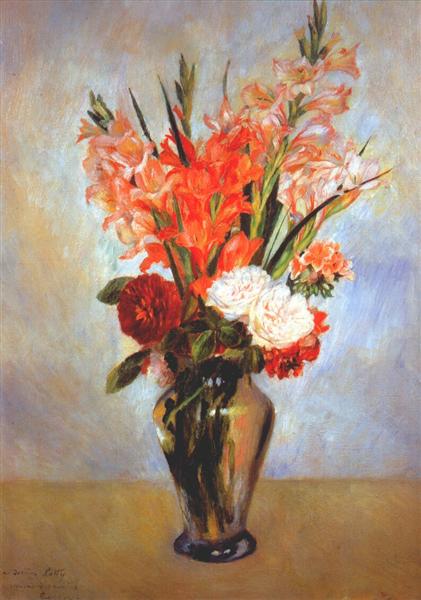Beschrijving
Het schilderij "Gladiolos" (1885) van Pierre-Auguste Renoir is een werk dat de levendige en kortstondige essentie van natuurlijke schoonheid samenvat door het meesterschap van de Franse impressionistische leraar. In dit werk richt Renoir zich op een veld van gladiolos, een bloem die kracht en eer symboliseert, meestal geassocieerd met elegantie in bloemen ornamenten. Deze keuze weerspiegelt de interesse van vernieuwing in de elementen van de natuur, evenals het vermogen van deze bloemen om intense emoties op te roepen door hun kleur en vorm.
De artistieke compositie van "Gladiolos" valt op voor zijn visuele balans. Het bloemenboeket beslaat het centrale deel en vormt een directe verbinding met de kijker. De bloemen, met hun ingewikkelde inzet van bloemblaadjes, lijken in volle bloei te zijn, een getuigenis van de aandacht voor detail die het werk van vernieuwing kenmerkt. De dichte instelling van de bloemen wordt aangevuld met een fonds dat, hoewel minder gedefinieerd, een essentieel contrast biedt waarmee gladiolen zich kunnen onderscheiden met een voelbare intensiteit.
In termen van kleur gebruikt Renoir een rijk en gevarieerd palet dat de uitbundigheid van bloemen verbetert. Rose, rode en witte tonen domineren de scène, elke kleur is van toepassing met een losse en dynamische aanraking, typisch voor de impressionistische stijl. De manier waarop kleuren met elkaar omgaan, roept een gevoel van frisheid en vitaliteit op, een van de meest gevierde kenmerken van het renovatiewerk dat duidelijk wordt in dit schilderij. Het licht, dat door de bloemblaadjes lijkt te worden gefilterd, geeft hen een bijna etherische glans, wat de vergankelijkheid van schoonheid suggereert.
Hoewel "Gladiolos" een dode aard is, blijft de afwezigheid van menselijke karakters geen dimensie om te werken; Integendeel, het geeft aandacht aan de aandacht om zich volledig te concentreren op de zintuiglijke inzet van bloemen. Deze beslissing om zich te concentreren op de natuur geeft een intiem verband tussen de toeschouwer en alledaagse objecten, waarbij de waardering voor het sublieme in het schijnbaar gewone wordt benadrukt. Renoir onderzocht gedurende zijn hele carrière hoe het gemeenschappelijke kan worden verheven tot het buitengewone, en "Gladiolos" is een perfect voorbeeld van dit uitgangspunt.
Het is interessant om op te merken dat Renoir in de jaren 1880 in een evolutionaire fase was in zijn carrière en nieuwe gewaagde technieken en stijlen testte. De vaste karakterisering van licht en sfeer in dit werk kan worden gezien als een evolutie naar een meer picturale benadering, waarbij kleuren een viering van de kunst zelf worden. De bloemen zijn daarom niet alleen een onderwerp, maar ook een manifestatie van de zoektocht om te vernieuwen naar harmonie en schoonheid in zijn puurste vorm.
"Gladiolos" draagt bij aan een breder corpus van bloemenwerken in de kunstgeschiedenis, waar naturalisme en impressionisme samenkomen om de essentie van de natuur op vluchtige tijden vast te leggen. Dit werk vertegenwoordigt niet alleen een fase in de carrière van Renoir, maar ook geregistreerd in een artistieke dialoog die de link tussen de natuurlijke en de picturale weergave onderzoekt. Renoir, met zijn meesterlijke vermogen om licht, kleur en textuur vast te leggen, nodigt ons uit om schoonheid te waarderen op de eenvoudigste momenten, een erfenis die diep resoneert in de hedendaagse toeschouwer. Door "Gladiolos" herinnert Renoir ons eraan dat ware schoonheid zich bevindt in het vermogen om te worden waargenomen en gewaardeerd in elke vorm en kleur die de natuur ons biedt.
KUADROS ©, een beroemde verf op je muur.
Handgemaakte olieverfschilderijen, met de kwaliteit van professionele kunstenaars en de onderscheidende afdichting van KUADROS ©.
Foto's Reproductieservice met tevredenheidsgarantie. Als u niet helemaal tevreden bent met de replica van uw schilderij, betalen wij uw geld 100%terug.

